| 1 | A common Indian farmland snake |

It’s fair to say that most Western tourists would react to seeing a snake in the Indian countryside with bone-paralysing fear. Unlike Britain, with its tiny list of 3 snake species, India has dozens of venomous snakes, among over 300 snake species overall. The average layman can only identify one or two, and even then, he still wouldn’t be sure on the night.
Fortunately, there’s one Indian snake you can randomly encounter without having a mild heart attack: the trinket snake (Coelognathus helena). This is a 100-140cm long snake (max 168cm) within a thin body, which is fairly common all over India, as well as Nepal, Sri Lanka and Bangladesh. It’s a non-venomous constrictor which has never killed a human, and is more famous for its beautiful, sculpted appearance instead.
The trinket snake isn’t astonishingly vibrant with electric or jungle green colours, but sleek and elegant, like an ornament in a temple. Newborns are brighter than adults, with an earthy yellow which gradually shifts towards beige-brown as they age. One tell-tale feature of this snake is several jet black stripes on its neck, and one below each eye. Its belly, meanwhile, is a pristine white.
| 2 | Named after Helen of Troy? |

The name of the trinket snake has particularly foggy origins. Its Latin name is Coelognathus helena, and the popular theory is that this originated from Helen of Troy, the semi-mythical Greek princess. Helen was heir to the spartan kingdom, who scandalously ran away with Paris of Troy around 700BC, triggering a 10 year war in order to reclaim her. Helen of Troy was said to be so beautiful that her mere existence sparked rage, war and death.
The trinket snake was first recorded in 1796 by Patrick Russell, who the extremely deadly Russell’s viper is also named after. Supposedly, Russell described the new snake as exceedingly pretty in his preliminary reports. When Francois Daud wrote the first official description in 1802, he took inspiration from Russell’s comments to call it Coelognathus helena.
However, some theorise that helena could reference a completely unknown, yet equally beautiful Helen. Meanwhile the local Sinhalese have their own names for the trinket snake, such as “Mudu Karavala” or “Kalu Kateya”.
| 3 | Disguises itself as bamboo |
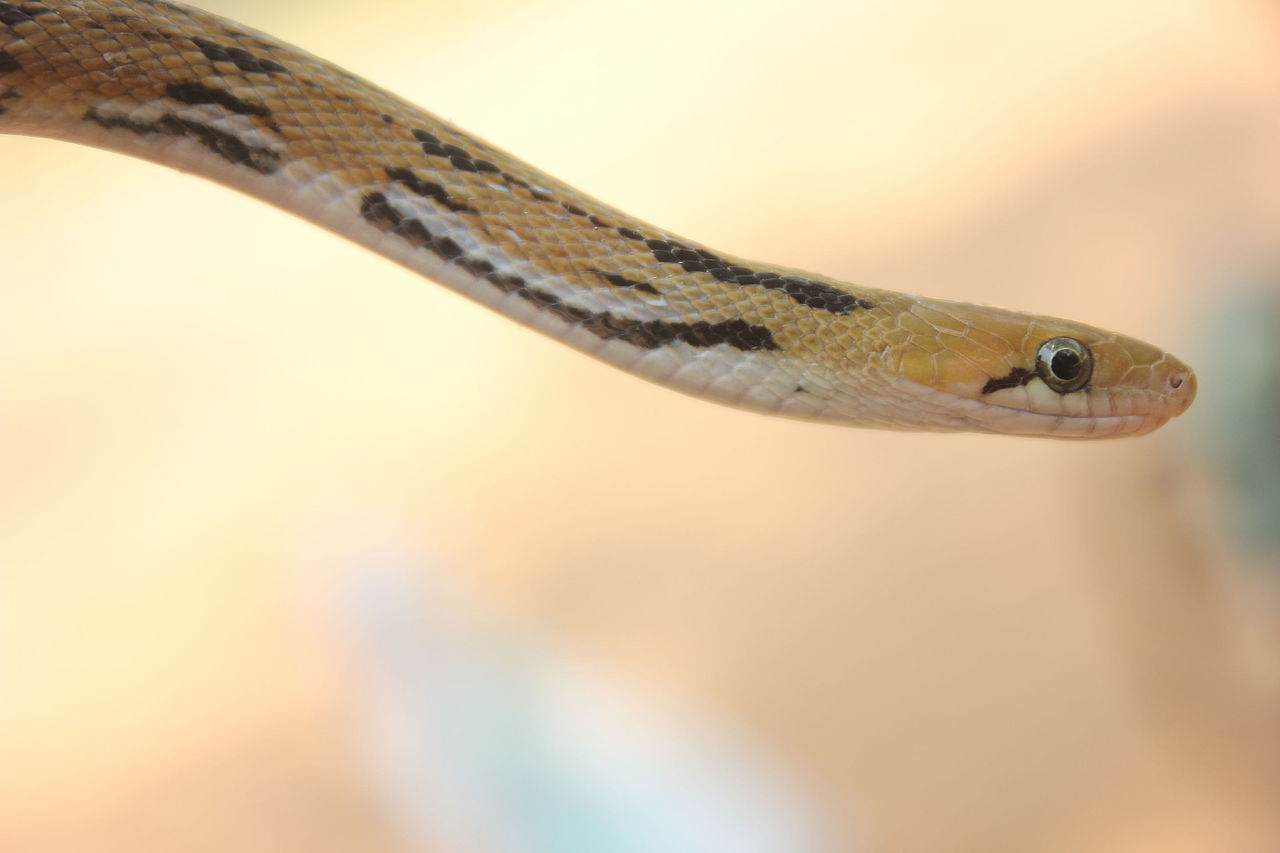
There are many defence tricks in the snake world, with the coachwhip sending a rush of blood to its eyes to enhance its vision. The trinket snake is an expert at camouflage, as one scientist observed in the Melghat Tiger reserve of eastern India.
At 10:24pm on December 17th 2017, he spotted a 1.4 metre trinket snake, lying on the ground with its body twisted unnaturally at several points. Instead of a sleek, shiny snake which a passing hawk might fancy, this trinket snake looked more like a fallen bamboo stick. For 15 minutes, the snake stayed perfectly still, adjusting its body occasionally and raising its head only slightly.
Predatory birds have very specific things which set them off, like shiny scales moving through the undergrowth, or a specific orange pattern. The trinket snake’s goal was to bypass this bird radar. Originally, only certain tree snakes were known to mimic bamboo as a disguise, but trinket snakes are a new addition.
| 4 | Requires high humidity and rainfall |
Trinket snakes are a common Indian species, occurring across almost the entire Indian subcontinent. They cover the entire island of Sri Lanka, from Jaffna in the dry north to Ratnapura in the humid south. They’re also found in Nepal in the Himalayan foothills, at up to 1500 metres. In India, they’re particularly common in Kashmir, Assam, Sikkim and Madras. The eastern Ghats in southeast India are home to the arrow-headed trinket snake subspecies (C.h. nigriangularis).
Its environments are ever-changing, including the edges of rainforests, meadow clearings, and moderately forested areas. Trinket snakes often appear in rice fields and other agricultural zones; one study spotted a trinket snake curled up in the latex-collecting jar of a rubber field.
However, the united feature of its habitats is an average rainfall of 2000mm or more, and an average temperature of 20C. Trinket snakes are creatures of the moist and warm, preferring humidity levels between 75% and 85%. Their shelter spots are equally variable, including termite mounds, rocks and rotting logs.
| 5 | Coexists with killers |
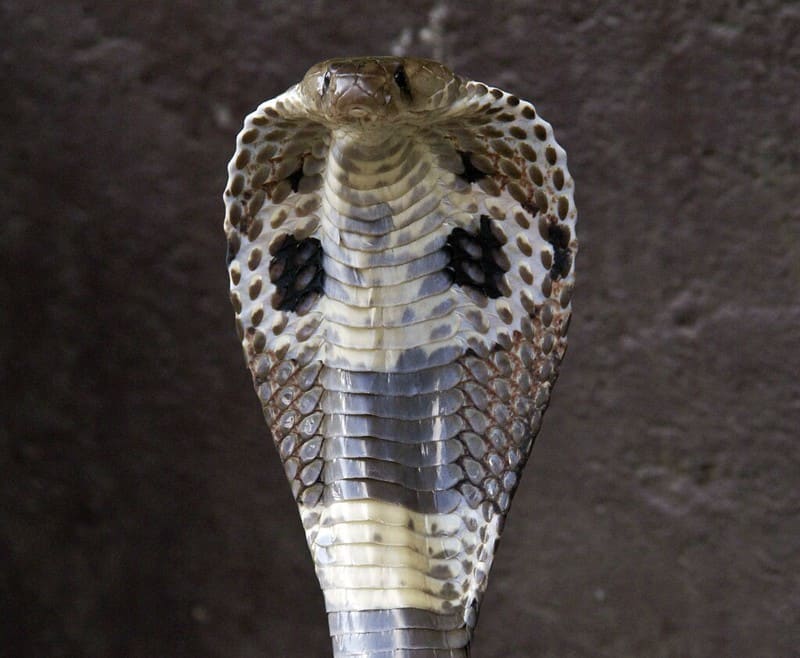
The trinket snake often lives in its own mini snake society. They’re strongly attracted to rice paddies, where a buffet of rodent prey scurries around. However, so are two of India’s deadliest snakes: the Russell’s viper and Indian cobra, which collectively bite thousands of Indian agricultural workers per year. These snakes slither right past each other between the rows of crops, occasionally interacting, sometimes ignoring each other.
Trinket snakes might be harmless, but be warned: if one hisses at you loudly, there could be a quieter but deadlier snake lurking nearby. The harmless Indian ratsnake completes the crop field crew.
It’s estimated that 82% of Indian snake species were first described during British expeditions 150 years ago, some of which haven’t been sighted since. These expeditions laid down the first modern maps of India, and were often fatal for participants. Explorers would enter tangled jungles knowing full well that an undiscovered venomous creature could completely wipe them out. These days, India is well explored, but there are still vast stretches where it’s a slithering, venom-injecting nightmare.
| 6 | Willing to take on cobras |
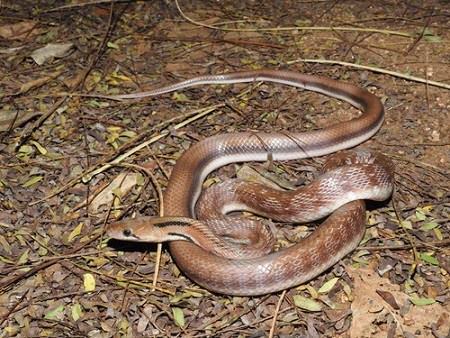
The trinket snake doesn’t necessarily like its neighbour snakes, as 21 year old photographer Vivek Patel discovered on October 4th 2017. He was accompanying his friends to Saputara in western India, as they released several captured snakes into the forest. Most disappeared quickly, but the keen-eyed Patel spotted a cobra staring hard at a trinket snake wrapped around a tree branch.
The icy standoff continued, with neither snake budging. Suddenly, the venomous cobra made a slight movement of its head. Like a bullet, the trinket snake darted forward and wrapped its entire jaws around the cobra’s face. The trinket snake delivered a sharp warning bite, and Patel captured intimate photos of its fangs still embedded in the cobra’s head.
Despite the cobra’s corrosive venom, which could destroy the trinket snake with one bite, it took the message and fled to another route. The little trinket snake had won the battle through sheer aggression, and Patel had the photos to prove his story.
| 7 | Bursts of aggression |
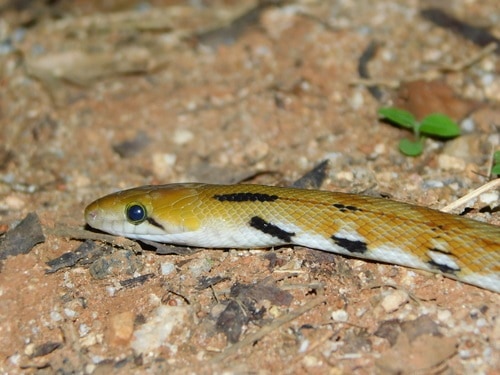
Trinket snakes can be aggressive towards innocent people, even if they’ve never been recorded to kill anybody. They have inward pointing teeth which can rip the flesh and draw blood, and are quite bad tempered, particularly males. They sometimes resort to fleeing, but are equally likely to strike the passerby they perceive as an aggressor.
Trinket snakes have their own warning display, where they raise the upper third of their body into the air and curve it in an s-shape, with their mouth slightly open (but with no tongue wagging). Sometimes they’ll lunge forward in a warning, and advance a few centimetres in the process, but trinket snakes are also known to headbutt potential predators.
Trinket snakes are decent tree climbers, and will sometimes scamper into a mid-height bush, despite being a ground dweller generally. The species is mostly active at night and dawn, and tends to appear next to small bodies of water, particularly when young.
| 8 | Diet: unfussy but prefers rodents |
Trinket snakes aren’t close to fully researched, and diet is one black hole of knowledge. The four-lined snake of Italy has the woodmouse as its trusted staple, but there’s no confirmed equivalent for trinket snakes. However, there’s a few confirmed lizard prey: Calotes versicolor, Otocryptis wiegmanni and Mabuya carinata lanakae.
Captive breeders have also made discoveries, including that young trinket snakes happily gobble down insects like field crickets. They’ll also eat frozen hairless pinkie mice, from two weeks old to adulthood. However, trinket snakes much prefer live prey, probably because it fulfils their natural instincts as a constrictor.
In the wild, the trinket snake sneaks up on prey slowly using its camouflage, rather than waiting motionless in ambush. Using its razor sharp teeth, the trinket snake will grind down a rodent’s resistance using repeated and savage bitings, before applying bodily coils and constricting. The boa constrictor is very different, as its teeth are used solely to grip prey.
| 9 | The Coelognathus clan |
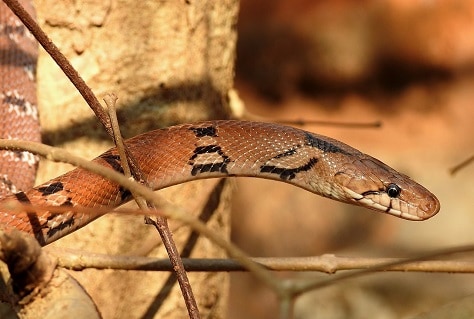
The trinket snake is divided into 3 confirmed subspecies. The most common is Coelognathus helena helena, but the most interesting is C. h. nigriangularis. This version has a black, arrow-shaped marking starting at the neck and pointing down the head. It inhabits the low, rolling eastern Ghats mountain range of southeast India, and is the rarest subspecies of the three.
The 3rd subspecies is the montane trinket snake (C. h. monticollaris), found in the western Ghats of southwest India. C. h. monticollaris has a dark body colour, with horizontal stripes rather than vertical, which are black and white rather than the plain black of C. h. helena.
There’s also variation within the main subspecies, as C. h. helena has more elaborate patterns the further north you travel in India. Some believe that C. h. monticollaris is in fact two subspecies divided between rainforests in the southern western Ghats and temperate landscapes in the north.
Then there’s evolution. Travelling back in time, the closest relative of the trinket snake is probably the radiated ratsnake (Coelognathus radiatus), which still lives in India today. It’s believed that the two diverged 30 million years ago, around the time India first crashed into the Eurasian tectonic plate.
| 10 | Copes well with captivity |
Generally, it’s lazy snake species that succeed in captivity, like the emerald tree boa, which normally sticks to a rainforest branch and barely moves anyway. However, the trinket snake is an active snake that fares well with keepers.
Snake expert Paul Kornacker ran a long experiment through the 1970s and 80s which led to a female trinket snake surviving 14 years. The first trinket snakes were caught in 1974, and by 1981 Kornacker had produced a clutch of eggs. He filled the cage with a 10cm deep mixture of sand, earth and peat, with constantly rotating lamps to mimic the day/light cycle of the wild. One time, Kornacker cured a lung infection in a trinket snake by infusing the “soil” with several drops of eucalyptus oil.
The long-lasting mother produced 51 eggs over 14 years, with 29 hatchlings. These great results were achieved by feeding the snakes laboratory mice exclusively. Another of his methods was to give the trinket snakes a multivitamin every 8 weeks (SnakeTech brand maybe).
